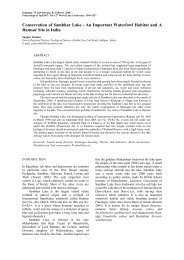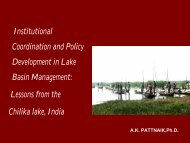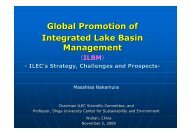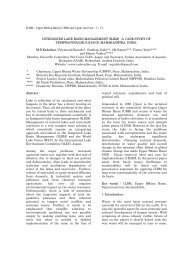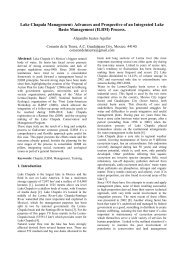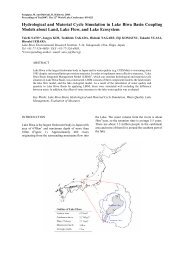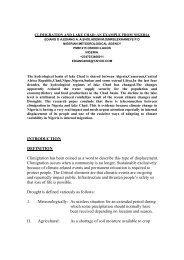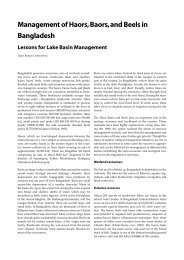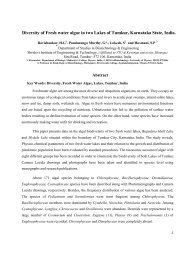Use of endoparasites, Ligula intestinalis plerercoid in ...
Use of endoparasites, Ligula intestinalis plerercoid in ...
Use of endoparasites, Ligula intestinalis plerercoid in ...
You also want an ePaper? Increase the reach of your titles
YUMPU automatically turns print PDFs into web optimized ePapers that Google loves.
<strong>Use</strong> <strong>of</strong> <strong>endoparasites</strong>, <strong>Ligula</strong> <strong><strong>in</strong>test<strong>in</strong>alis</strong> <strong>plerercoid</strong> <strong>in</strong> Rastreneobola argentea tobiomonitor <strong>in</strong>creas<strong>in</strong>g metal contam<strong>in</strong>ation <strong>in</strong> waters <strong>of</strong> Lake VictoriaElijah Oyoo-Okoth 1* ., Leah Cherop 1 , Victoria Chepkirui-Boit 1 , Odipo Osano 2 , Veronica Ngure 31 Department <strong>of</strong> Fisheries and Aquatic Sciences, Moi University, Eldoret, Kenya, P.O. Box 1125, Eldoret - Kenya.2 School <strong>of</strong> Environmental Studies, Moi University, P.O. Box 3900, Eldoret.3 Department <strong>of</strong> Wildlife Management, Moi University, Eldoret, Kenya, P.O. Box 1125, Eldoret - Kenya.* Correspond<strong>in</strong>g author Tel No: +254720222082 Email: elijaoyoo@yahoo.comAbstract: The ability <strong>of</strong> <strong>endoparasites</strong> to detecteven lowest metal concentration due to their enormousaccumulation capacity has made them suitable waterpollution biomonitors than their fish hosts. This studyevaluated the metal accumulation ability <strong>of</strong> <strong>Ligula</strong><strong><strong>in</strong>test<strong>in</strong>alis</strong> <strong>in</strong> its <strong>in</strong>termediate cypr<strong>in</strong>id host silversard<strong>in</strong>e (Rastreneobola argentea) from Lake Victoria<strong>in</strong> the natural environment and <strong>in</strong> laboratory conditionas a possible sent<strong>in</strong>el tool to biomonitor five metals.Metal concentration <strong>in</strong> fish and parasites exhibitedsite-specific variations relative to the anthropogenicactivities along the coastal zone <strong>of</strong> Lake Victoria. Thefish bioaccumulated lead (Pb), cadmium (Cd),chromium (Cr), and copper (Cu) by factor 5.2, 4.2, 6.4and 3.5 respectively than its host under normalenvironmental conditions <strong>of</strong> the lake. When the metalcontent <strong>in</strong> water with<strong>in</strong> the experimental unitsconta<strong>in</strong><strong>in</strong>g fish and parasites were <strong>in</strong>creased ten-foldthan metal concentration <strong>of</strong> the lake water <strong>in</strong> thelaboratory, all heavy metal concentrations <strong>in</strong> L.<strong><strong>in</strong>test<strong>in</strong>alis</strong> <strong>in</strong>creased between 10 to 35 time higherthan the concentration <strong>in</strong> tissues <strong>of</strong> its host. This studysupports a recommendation <strong>of</strong> <strong>in</strong>corporat<strong>in</strong>g thecestode endoparasite (L. <strong><strong>in</strong>test<strong>in</strong>alis</strong>) <strong>in</strong> a cypr<strong>in</strong>id host(R. argentea) as suitable early warn<strong>in</strong>g bio-<strong>in</strong>dicator<strong>of</strong> heavy metal pollution and should thus be useful totrack <strong>in</strong>creas<strong>in</strong>g localized heavy metal pollution.Keywords: Biomonitor, Heavy metals, Lake Victoria,<strong>Ligula</strong> <strong><strong>in</strong>test<strong>in</strong>alis</strong>, Rastreneobola argentea.1. IntroductionParasites are an essential part <strong>of</strong> the aquaticenvironment and represent a significant proportion <strong>of</strong>aquatic biomass. The relationship betweenenvironmental pollution and parasitism <strong>in</strong> aquaticorganisms and the potential role <strong>of</strong> <strong>endoparasites</strong> aswater quality <strong>in</strong>dicators have received <strong>in</strong>creas<strong>in</strong>gattention dur<strong>in</strong>g the past two decades (Sures, 2003;Sures, 2004). S<strong>in</strong>ce parasites are sensitive toenvironmental change, others are more resistant thantheir hosts and tend to <strong>in</strong>crease <strong>in</strong> numbers <strong>in</strong> pollutedconditions (Sures, 2004); they are now regarded as auseful <strong>in</strong>dicator <strong>of</strong> aquatic health.Fish, parasite and metal <strong>in</strong>teractions havegenerated large pool <strong>of</strong> literature from environmentalpollution monitor<strong>in</strong>g perspective (Sures et al.1994a,b,c; Sures and Taraschewski, 1995; Sures et al.,1999; Dvovareck et al. 2000; Sures, 2001; Sures,2003; Schludermann et al., 2003; Sures and Reimann,2003; Thielen, et al., 2004; Tek<strong>in</strong>-Ộzan and Kir, 2005;Tek<strong>in</strong>-Ộzan and Barlas, 2008). A major conclusionfrom these literature revealed that for different host–parasite associations, <strong>in</strong>test<strong>in</strong>al parasites accumulate anumber <strong>of</strong> metals to concentrations several hundredtimes higher than the levels <strong>in</strong> host tissues (Sures,2001, 2003, 2004; Thielen, et al., 2004) thus renderparasites sensitive metal accumulation biomonitorsthan their fish host. Recently Sures (2007) <strong>in</strong>dicatedthat parasites can also act as metal s<strong>in</strong>ks for its fishhost. It is apparent that any changes to metalconcentration <strong>in</strong> the fish tissues are likely to altermetal bioavailability and toxicity.One important question <strong>in</strong> the host-parasiteevolutionary ecology (Poul<strong>in</strong>, 1998) is whetherparasite-host <strong>in</strong>duced modification observed <strong>in</strong> bothnatural and experimental conditions is adaptive orsimply co<strong>in</strong>cident (Williams, 1992). Whendeterm<strong>in</strong><strong>in</strong>g the bio-availability and toxicity <strong>of</strong> metalsto fish <strong>in</strong> presence <strong>of</strong> <strong>endoparasites</strong>, the resultsobta<strong>in</strong>ed are variable and studies conducted <strong>in</strong> thefield <strong>of</strong>ten differ with those <strong>in</strong> the laboratory (Luomaand Ra<strong>in</strong>bow, 2008). Organisms under natural fieldconditions may respond quite differently to pollutantexposures, under laboratory conditions (Shugart,1996). Laboratory studies generally lack ecologicalrealism, because <strong>of</strong> many environmental factors thatcan <strong>in</strong>fluence organism responses at all levels <strong>of</strong>biological organisation (Adams, 2001). Accord<strong>in</strong>g toVerrengia-Guerrero et al. (2002), the extent <strong>of</strong>organism responses depends on the toxico-k<strong>in</strong>etic andtoxico-dynamic processes that occur once a metaltoxicant has entered the organism. Nonetheless, thereare very few field and laboratory studies on the metalconcentration <strong>in</strong> fish and its parasites.Currently, cestodes affect large number <strong>of</strong> fishspecies and can survive <strong>in</strong> wide and highly variableenvironments (Jirsa et al. 2008). Further studies onsystematically different parasites from differentmicrohabitats <strong>in</strong> fish as well as from differentenvironments are required for cestode-fish hostgroup<strong>in</strong>g as a way to further the development <strong>of</strong>biomonitor<strong>in</strong>g tools for metal contam<strong>in</strong>ation <strong>in</strong> theaquatic environments. For this, the aim <strong>of</strong> this studywas to evaluate the metal accumulation ability <strong>of</strong> acestode (L. <strong><strong>in</strong>test<strong>in</strong>alis</strong>) <strong>in</strong> a cypr<strong>in</strong>id fish host (R.argentea) as a possible sent<strong>in</strong>el host-parasite1
association <strong>in</strong> monitor<strong>in</strong>g <strong>in</strong>creas<strong>in</strong>g heavy metalpollution <strong>in</strong> lacuster<strong>in</strong>e environment. This hostparasiteassemblage was analyzed at different sites toidentify the variable metal exposure <strong>in</strong> the coastalzone <strong>of</strong> Lake Victoria.2. Materials and methods2.1 Study area and sampl<strong>in</strong>g sitesLake Victoria, the second largest freshwater body<strong>in</strong> the world (area 68,800 km 2 ), is generally shallow(mean depth 40 m) and lies <strong>in</strong> a catchment <strong>of</strong> about184,000 km 2 , shared by three riparian states (Kenya,Tanzania and Uganda). Site selection <strong>in</strong> Kenya wasbased on the anthropogenic activity pr<strong>of</strong>iles along thecoastal zones (Fig. 1). Site 1 (Kisumu City) has apopulation <strong>of</strong> about 1.1 Million and is a centre <strong>of</strong>urban development with various <strong>in</strong>dustries anddra<strong>in</strong>age <strong>of</strong> <strong>in</strong>tense agriculture. Site 2 (Kendu-Bay) isa rural agricultural area without fertilizer <strong>in</strong>puts. Site 3(Karungu) receives dra<strong>in</strong>age from small gold m<strong>in</strong>es.Site 4 (Port Victoria) is a rural area, receiv<strong>in</strong>g waterfrom the River Nzoia, conta<strong>in</strong><strong>in</strong>g effluents from twosugar factories and a paper mill factory situated about100-150 km upstream from the Lake.L. <strong><strong>in</strong>test<strong>in</strong>alis</strong> <strong>in</strong>volves three hosts, a crustacean(copepod), a fish (e.g. R. argentea) and a bird (e.g.pied K<strong>in</strong>gfisher or Cormorant). Copepods carry<strong>in</strong>fective stages <strong>of</strong> the parasite, which are transferredto the fish R. argentea and subsequently to the fishconsumers <strong>in</strong> the coastal zone <strong>of</strong> the Lake Victoria.Accumulated metals are thus transferred via the samefood cha<strong>in</strong>.Fish samples were obta<strong>in</strong>ed from local fishermenon two sampl<strong>in</strong>g occasions <strong>in</strong> June 2006 from the sitesS1, S2, S3 and S4 us<strong>in</strong>g a beam trawl with 5 mmstretched mesh; fish was attracted <strong>in</strong> the night bylamps. The catch data are presented <strong>in</strong> Table 1. Tom<strong>in</strong>imize contam<strong>in</strong>ation, all materials used <strong>in</strong> theexperiment were previously washed <strong>in</strong> ultra purewater. Fish were weighed (to the nearest 0.1 g),measured (folk length <strong>in</strong> mm) and dissected.Dissection <strong>of</strong> the fish was done on the shore us<strong>in</strong>gsta<strong>in</strong>less steel <strong>in</strong>strument pre-cleaned <strong>in</strong> doubledistilled water. In parasitized fish, parasites wereremoved us<strong>in</strong>g sta<strong>in</strong>less steal <strong>in</strong>struments, counted,weighed and stored <strong>in</strong> glass vials and later transferredto Teflon vials and freeze dried, await<strong>in</strong>g furtheranalysis. Both parasitized and unparasitized fish werebagged and frozen until processed <strong>in</strong> the laboratoryus<strong>in</strong>g metal-free techniques <strong>in</strong> the Netherlands.2.3 Metal enrichmentsWater from Lake Victoria was enriched us<strong>in</strong>g Pb,Cd, Cr and Cu. The concentration <strong>of</strong> the specific metalapplied were 10 times the <strong>in</strong>itial concentration <strong>of</strong> theLake water <strong>in</strong> site 1. The parasitized and nonparasitized fish were then transferred to the water andleft <strong>in</strong> the solution for 96 h.Fig. 1. Map <strong>of</strong> Lake Victoria bas<strong>in</strong> (Kenya) show<strong>in</strong>g thesampl<strong>in</strong>g sites2.2 Fish and endoparasite collectionThe fish host chosen <strong>in</strong> this study was a cypr<strong>in</strong>id, R.argentea (Pellegr<strong>in</strong>, 1904). This fish occurs <strong>in</strong> a highabundance <strong>in</strong> Lake Victoria, more than any otherspecies. Dur<strong>in</strong>g the past eight years it has composedbetween 37 – 45% <strong>of</strong> the commercial fish catch(Wan<strong>in</strong>k, 1999). Due to its relatively low price, itdom<strong>in</strong>ates as a source <strong>of</strong> prote<strong>in</strong> among the poor lakeshore communities, ma<strong>in</strong>ly because other larger fishspecies are preferred for trade, <strong>in</strong>clud<strong>in</strong>g export for thecountry’s foreign exchange earn<strong>in</strong>g. The life cycle <strong>of</strong>2.4 Metal analysisThe frozen samples were thawed, crushed andhomogenized us<strong>in</strong>g a Fritsch, Pulverisette 5, planetarymill (Fritsch GmbH Laborgerate, Idar-Oberste<strong>in</strong>,Germany) for 5 m<strong>in</strong>utes at 400 rpm. About 0.5 g <strong>of</strong>sample were accurately weighed <strong>in</strong> Telflon (© polytetra-fluor-etheen(PTFE), DuPont) high pressurevessels. Then 4.0 ml concentrated nitric acid (65%),1.0 ml concentrated hydrochloric acid (37%) and 1.0ml ultra pure water was added to the samples. Sixsamples were placed <strong>in</strong> the carousel <strong>of</strong> a PaarMicrowave oven (Anton Paar GmbH – Graz –Austria).Digestion took place at 200°C and 70 bar pressuredur<strong>in</strong>g 15 m<strong>in</strong>utes. After cool<strong>in</strong>g the obta<strong>in</strong>ed clearsolutions were quantitatively poured <strong>in</strong> 50mlvolumetric flasks and diluted to the mark with ultrapure dem<strong>in</strong>eralized water. F<strong>in</strong>ally the diluted solutionswere transferred <strong>in</strong>to acid cleaned polyethylene bottles.All elements were determ<strong>in</strong>ed by means <strong>of</strong> <strong>in</strong>ductivelycoupled plasma-optical emission spectrometry (Perk<strong>in</strong>Elmer Optima 3000 XL, ICP-OES) us<strong>in</strong>g the PEcalibration standards. The concentrations werecalculated as mg kg -1 dry weight. The quality <strong>of</strong> theanalytical process was controlled by the analysis <strong>of</strong>IAEA MA-A-3/TM certified standard referencematerial <strong>of</strong> shrimp. Measured values deviated lessthan 10% from the certified values.2
2.5 Statistical analysesMetal concentrations <strong>in</strong> the biota were statisticallyanalysed us<strong>in</strong>g a one-way ANOVA. Post-Hoc HSDwas used for Post-hoc discrim<strong>in</strong>ation between themeans. Relationships between metal concentrations <strong>in</strong>the parasite and the fish were analyzed us<strong>in</strong>g l<strong>in</strong>earregression analysis.3. Results and discussionThe concentration <strong>of</strong> the four heavy metal (Pb, Cd,Cr and Cu) <strong>in</strong> water at the four sampl<strong>in</strong>g sitespreviously selected is shown <strong>in</strong> Tab. 1. Though thevariation <strong>in</strong> concentration among the sites was slight,the concentration <strong>of</strong> all metals displayed significantdifferences among sampl<strong>in</strong>g sites (P < 0.05).Sampl<strong>in</strong>g site 1, had higher levels <strong>of</strong> Pb, Cd and Cuthan other sites. However, the concentration <strong>of</strong> Cr wasfound to be elevated <strong>in</strong> site 3 when compared to othersites. This show evidence <strong>of</strong> anthropogenic <strong>in</strong>fluenceon heavy metal concentration, which resulted <strong>in</strong>differential spatial heavy metal distribution. Currentresults <strong>in</strong>dicate low levels <strong>of</strong> heavy metal whencompared to most countries (Neto et al. 2000; Fatokiand Mathabatha 2001; Ruiz 2001; Adamo et al. 2005;Chen et al. 2006) but signs <strong>of</strong> <strong>in</strong>creas<strong>in</strong>g heavy metalis evidence when compared to earlier studies <strong>in</strong> thisarea (Wandiga 1981; Wandiga et al. 1983; Onyari andWandiga 1989; Mwamburi and Oloo, 1997).Tab. 1 Concentration <strong>of</strong> the measured metals <strong>in</strong> water atthe sampl<strong>in</strong>g sitesHeavymetalsSampl<strong>in</strong>g sitesS1 S2 S3 S4Pb 1.0 ± 0.1 c 0.3 ± 0.05 b 0.3 ± 0.03 b 0.3 ± 0.02 aS<strong>in</strong>ce the variation <strong>in</strong> metallic concentrationswith<strong>in</strong> the aquatic organisms reflects the net effect <strong>of</strong>compet<strong>in</strong>g processes, encompass<strong>in</strong>g uptake anddepuration, bioaccumulation under describes the netaccumulation <strong>of</strong> a chemical <strong>in</strong>to the tissue <strong>of</strong> anorganism as a result <strong>of</strong> uptake from all environmentalsources (Burkhardt et al., 2003). Under normal waterenvironment, the uptakes <strong>of</strong> heavy metals are usuallymasked when the total heavy metal <strong>in</strong> water is low.The concentration <strong>of</strong> heavy metals <strong>in</strong> fish tissues and<strong>in</strong> the parasites <strong>in</strong> ambient water environment isshown <strong>in</strong> Fig. 2. Metal concentration <strong>in</strong> all the fishsamples displayed significant spatial variations as didthe specific metal contents <strong>in</strong> the fish parasites (P 0.05).The measured concentration <strong>of</strong> heavy metals <strong>in</strong>water after enrichment are shown <strong>in</strong> Tab. 2, whichreflect the total heavy metal content to be taken up bythe organism from the aquatic environment.Tab. 2 Measured heavy metal <strong>in</strong> enriched watermedia (from site 1)Heavy metalsHeavy metal concentrationPb 9.20 ± 0.74Cd 0.92 ± 0.22Cr 3.54 ± 0.42Cu 7.82 ± 0.32Metal concentrations mg kg -1 dw)40.0 Pb1.5 Cd32.024.016.08.00.05.04.03.02.01.00.0FishParasiteFishCrParasiteFishParasiteSampl<strong>in</strong>g sitesFig. 2. Heavy metal concentrations <strong>in</strong> fish and fishparasites (mg kg -1 dw) at the four sampl<strong>in</strong>g sites <strong>in</strong> LakeVictoriaFish1 2 3 4Parasite1.20.90.60.30.015.012.09.06.03.00.0FishParasiteFishParasiteCuFishParasiteFish1 2 3 4Parasite3
Chromium showed site specific bioaccumulationby parasites show<strong>in</strong>g higher concentration <strong>of</strong> metalcontent between parasites and host <strong>in</strong> site 2. This may<strong>in</strong>dicate environmental <strong>in</strong>fluence on the heavy metal,rather than the measured contents <strong>in</strong> fish that may<strong>in</strong>terfere with the physiological functions <strong>of</strong> theparasites <strong>in</strong> the host. In site 2, we observed golddeposits along the river bed that may <strong>in</strong>terfere with themetal accumulation <strong>in</strong> the fish. This variability, reflectthe mobility <strong>of</strong> the fish host and can obscure thedifferences that might be detected between sites.When the metal accumulation <strong>in</strong> fish parasitesand fish was compared <strong>in</strong> the enriched lake waterfrom site 1, the results are as shown <strong>in</strong> Tab. 3. Inenriched lake water, there was higher bioaccumulation<strong>of</strong> metals by a rang<strong>in</strong>g from 10 times to 35.Bioaccumulation is a well documented field <strong>of</strong>research (Ra<strong>in</strong>bow, 2007; Zimmermann et al., 2004;Sizmur and Hodson, 2009). Normally,bioaccumulation <strong>of</strong> metals is through highly specificphysiological uptake mechanisms (Chapman, 1997;Ra<strong>in</strong>bow, 2007) and reflects its exposure to pollutantsover time. Metals accumulate more rapidly than canbe elim<strong>in</strong>ated due to low molecular weights, metalb<strong>in</strong>d<strong>in</strong>g prote<strong>in</strong>s, such as metallothione<strong>in</strong>s (MT’s) andpresent <strong>in</strong> aquatic organisms. In addition, MT’scontrol the bioavailability and the k<strong>in</strong>etics <strong>of</strong>bioaccumulation as well as the toxic effects that occurvia the <strong>in</strong>duction <strong>of</strong> their biosynthesis (Baudrimont etal., 2003). For most fish, these <strong>in</strong>tracellular prote<strong>in</strong>sb<strong>in</strong>d specifically and have a high aff<strong>in</strong>ity for metals,such as Cd, Cu and Zn.In the aquatic environment, factors that canaffect bioaccumulation <strong>of</strong> metals <strong>in</strong>clude:environmental conditions, presence <strong>of</strong> specificbioavailable metal species (Ra<strong>in</strong>bow and Dall<strong>in</strong>ger,1993; Van G<strong>in</strong>neken et al., 1999), trophic status <strong>of</strong>bioaccumulation, physiological condition <strong>of</strong> theorganism, <strong>in</strong>teractions between metals and the uptakeand release rates (k<strong>in</strong>etics) <strong>of</strong> metals by an organism(Buchwalter and Luoma, 2005). In fish-parasiteassociation, the normal physiological function<strong>in</strong>g <strong>of</strong>fish is <strong>in</strong>terrupted though it is not clear, which amongthese factors will exert great control over metals <strong>in</strong> thefish system.Metal concentration <strong>in</strong> L. <strong><strong>in</strong>test<strong>in</strong>alis</strong> (mg kg -1 dw)the parasite tissues, albeit the <strong>in</strong>creased Pb and Crcontent <strong>in</strong> parasite relative to the fish tissues was morepredictable than the changes <strong>in</strong> Cd (Fig. 3). Thissuggest an uptake <strong>of</strong> metal by parasites from the fishtissues as the metal content <strong>in</strong> R. argentea <strong>in</strong>creasecomparable to the studies <strong>in</strong>volv<strong>in</strong>g heavy metaluptake k<strong>in</strong>etics <strong>in</strong> parasites <strong>in</strong> fish tissues. On theother hand, <strong>in</strong>creased Cu burden <strong>in</strong> the fish tissues wasassociated with l<strong>in</strong>ear reduction <strong>of</strong> the Cu <strong>in</strong> thetissues <strong>of</strong> the parasites. The present decl<strong>in</strong>e <strong>in</strong> Cu <strong>in</strong>parasite host as it <strong>in</strong>creases <strong>in</strong> fish host was <strong>in</strong>terpretedas elemental competition for essential element.Parasites and fish host have been shown to competefor several elements such as Ca, Cu, Fe, Zn and Sr <strong>in</strong>perch (Sures, 2002). Though there is paucity <strong>of</strong> dataon studies deal<strong>in</strong>g with simultaneous analysis <strong>of</strong>different elements <strong>in</strong> fish, and even less studiesdeal<strong>in</strong>g with metal k<strong>in</strong>etic and metal metabolism <strong>in</strong>fish-parasite association, it is probable thatcompetition for elements between host and parasitesfor essential elements could lead to <strong>in</strong>creasedabsorption <strong>of</strong> other essential metals <strong>in</strong>clud<strong>in</strong>g Cu.Concentrations <strong>of</strong> Cu may be regulated by the fish aswell as by the parasite, albeit the physiologicallyrequired levels are actually higher <strong>in</strong> the parasite.These higher Cu concentrations should therefore notbe construed as bioaccumulation <strong>of</strong> environmentalpollutants.50.040.030.020.010.00.05.04.03.02.01.0Pb y = 3.6564x + 1.273R 2 = 0.57220.0 2.0 4.0 6.0 8.0 10.0Cr14.0y = 4.2418x + 0.9463R 2 = 0.60012.402.001.601.200.800.4012.010.08.0Cd y = 7.1748x + 0.3049R 2 = 0.4240.05 0.10 0.15 0.20 0.25Cuy = -0.9226x + 15.835R 2 = 0.4985Tab. 3 Heavy metal concentration <strong>in</strong> fish, parasite andthe overall bioaccumulation factor0.00.0 0.2 0.4 0.6 0.8 1.0 1.26.03.0 4.0 5.0 6.0 7.0 8.0Heavy metal concentrationBioconcentrationHeavymetals Fish Parasite factorPb36.22 ± 4.2 421.65 ± 10.2 11.6Cd0.78 ± 0.12 27.6 ± 1.92 35.4Cr3.95 ± 0.42 42.65 ± 1.44 10.8Cu11.01 ± 1.12 102.4 ± 5.55 10.2Increased content <strong>of</strong> Pb, Cd and Cr <strong>in</strong> R. argentearesulted to correspond<strong>in</strong>g <strong>in</strong>crease <strong>of</strong> these metals <strong>in</strong>Fig. 3. Regression models show<strong>in</strong>g the relationshipsbetween metal concentration (mg kg -1 dw) <strong>in</strong> L.<strong><strong>in</strong>test<strong>in</strong>alis</strong> aga<strong>in</strong>st metal concentration <strong>in</strong> <strong>Ligula</strong><strong><strong>in</strong>test<strong>in</strong>alis</strong>4. ConclusionHeavy metal concentration <strong>in</strong> R. argentea (mg kg -1 dw)The present study shows that the L. <strong><strong>in</strong>test<strong>in</strong>alis</strong> <strong>in</strong>R. argentea accumulates heavy metals <strong>in</strong> variablequantities <strong>in</strong> fish host. Some heavy metals such as Pb,Cd and Cr were bio accumulated by upto factor 11, 18and 14 respectively and Cu by factor 2.5 <strong>in</strong> the fish4
<strong>endoparasites</strong> <strong>in</strong> the natural water environment. Whenthe metal content <strong>in</strong> water with<strong>in</strong> the experimentalunits conta<strong>in</strong><strong>in</strong>g fish and parasites were <strong>in</strong>creased tenfoldthan metal concentration <strong>of</strong> the lake water <strong>in</strong> thelaboratory, all heavy metal concentrations <strong>in</strong> L.<strong><strong>in</strong>test<strong>in</strong>alis</strong> <strong>in</strong>creased between 10 to 35 time higherthan the concentration <strong>in</strong> tissues <strong>of</strong> its host. WhereasCu was demonstrated to be subject <strong>of</strong> elementcompetition between fish and parasite, Pb, Cd and Crdisplayed a partition<strong>in</strong>g <strong>in</strong> the fish host with parasiteshav<strong>in</strong>g higher concentration <strong>of</strong> these metals, whichwould render the <strong>Ligula</strong> <strong><strong>in</strong>test<strong>in</strong>alis</strong> <strong>in</strong> R. argenteahost a suitable as bio-monitor for exposure to thesemetals. It is evident that L. <strong><strong>in</strong>test<strong>in</strong>alis</strong> is sensitive<strong>in</strong>dicator and early warn<strong>in</strong>g sign for <strong>in</strong>creas<strong>in</strong>g Pb, Cdand Cr pollution. Given that the parasite is easy toidentify even <strong>in</strong> different host (Olson et al. 2000;Tek<strong>in</strong>-Özan and Kir Tek<strong>in</strong>-Örzan and Barlas 2008), itshigh abundance and high prevalence, it was found tobe suitable bio-monitor model for early warn<strong>in</strong>g signfor localized pollution by Pb, Cd and Cr <strong>in</strong> LakeVictoria.AcknowledgmentsThe authors would like to thank the RoyalNetherlands Embassy <strong>in</strong> collaboration with VictoriaInstitute for Research on Environment andDevelopment (VIRED) International for fund<strong>in</strong>g thisproject. The LVEMP Project also provided additionalsupport to which we are grateful. The authors thankMr. Lewela <strong>of</strong> Moi University, Biochemical Analysislaboratory for the <strong>in</strong>valuable assistance <strong>in</strong> samplecollection and analysis <strong>of</strong> heavy metals.References[1] B. Sures, Accumulation <strong>of</strong> heavy metals by <strong>in</strong>test<strong>in</strong>alhelm<strong>in</strong>ths <strong>in</strong> fish, facts, appraisal and perspectives.Parasitol. 126: 53-60, 2003.[2] B. Sures, Environmental parasitology: relevancy <strong>of</strong>parasites <strong>in</strong> monitor<strong>in</strong>g environmental pollution. Trends<strong>in</strong> Parasitol. 20(4): 170-177, 2004.[3] B. Sures, H. Taraschewski, and E. Jackwerth, Leadaccumulation <strong>in</strong> Pomphorhyncus laevis and its host. J.Parasitol. 80: 355-357, 1994a.[4] B. Sures, H. Taraschewski, and E. Jackwerth, Leadcontent <strong>of</strong> Paratenuisentis ambiguous (Acanthocephala),Anguillicola crassus (Nematodes) and their hostsAnguilla anguilla. Dis. Aquat. Org. 19: 105-107, 1994b.[5] B. Sures, H. Taraschewski. and E. Jackwerth,Comparative study <strong>of</strong> lead accumulation <strong>in</strong> differentorgans <strong>of</strong> perch (Perca fluviatilis) and its <strong>in</strong>test<strong>in</strong>alparasite Acanthocephalus lucii. Bull. Environ. Contam.Toxicol. 52: 269-273, 1994c.[6] B. Sures and H. Taraschewski, Cadmium concentration<strong>in</strong> two adult acanthocephalans, Pomphorynchus laevisand Acanthocephalus lucii, as compared with their fishhosts and cadmium levels <strong>in</strong> larvae <strong>of</strong> A. lucii ascompared with their crustacean host. Parasitol. Res. 81:494-497, 1995.[7] B. Sures, R. Siddall. and H. Taraschewski, Parasites asaccumulation <strong>in</strong>dicators <strong>of</strong> metal pollution. Internat. J.Parasitol. 33: 65-70. 1999.[8] J. Dvoracek, F. Tenora, V. Barus, and S. Kracmar,Concentrations <strong>of</strong> some heavy metals <strong>in</strong> <strong>Ligula</strong><strong><strong>in</strong>test<strong>in</strong>alis</strong> plerocercoids (Cestoda) and Philometraovata (Nematoda) compared to some their hosts(Osteichthyes). Helm<strong>in</strong>thol. 37(1):15-18, 2000.[9] B. Sures, The use <strong>of</strong> fish parasites as bio<strong>in</strong>dicators <strong>of</strong>heavy metals <strong>in</strong> aquatic ecosystems, a review. Aquat.Ecol. 35: 245-255, 2001.[10] C. Schludermann, S. Konecyny, S. Laimgruber, J.W.Lewis, F. Schiemer, A. Chovanec. and B. Sures, Fishmacroparasites as <strong>in</strong>dicator <strong>of</strong> heavy metal pollution <strong>in</strong>river sites <strong>in</strong> Austria. Parasitol. 126: 61-69, 2003[11] B. Sures and N. Reimann, Analysis <strong>of</strong> the trace metals<strong>in</strong> the Antactic host-parasite system Nototheniacoriiceps and Aspersentis megarhynchus(Acanthocephala) caught at K<strong>in</strong>g George Island, SouthShetland Islands. Polar Biol. 26: 680-686, 2003.[12] F. Thielen, S. Zimmermann, F. Baska, H. Taraschewski,and B. Sures, The <strong>in</strong>test<strong>in</strong>al parasite Pomphorhyncuslaevis (Acanthocephala) from barbel as bio<strong>in</strong>dicator formetal pollution <strong>in</strong> the Danube River near Budapest,Hungary. Environ. Pollut. 129: 420-429, 2004.[13] B. Sures, Host-parasite <strong>in</strong>teractions from anecotoxicological perspective. Parasitol. 47(3): 173-176,2007.[14] S. Tek<strong>in</strong>-Özan and I. Kir, Comparative study on theaccumulation <strong>of</strong> heavy metals <strong>in</strong> different 291 organs<strong>of</strong> tench (T<strong>in</strong>ca t<strong>in</strong>ca L. 1758) and plerocercoids <strong>of</strong> itsendoparasite <strong>Ligula</strong> <strong><strong>in</strong>test<strong>in</strong>alis</strong>. Parasitol. Res. 97:156-69, 2005.[15] S. Tek<strong>in</strong>-Özan, and M. Barlas, Concentration <strong>of</strong> heavymetals <strong>in</strong> <strong>Ligula</strong> <strong><strong>in</strong>test<strong>in</strong>alis</strong> L., 1758 plerocercoids(Cestoda) compared to its host’s (T<strong>in</strong>ca t<strong>in</strong>ca L., 1758)organs from Beyşehir Lake (Turkey). Helm<strong>in</strong>thol.45(2): 76-80, 2008.[16] B, Sures, Host-parasite <strong>in</strong>teractions from anecotoxicological perspective. Parasitol. 47(3): 173-176,2001.[17] R. Poul<strong>in</strong>, Evolutionary ecology <strong>of</strong> parasites: From<strong>in</strong>dividuals to community. Chapman and Hall Ltd:London, UK, 1998.[18] G.C. William, Natural selection: Doma<strong>in</strong>s, levels andchallenges. Oxford University Press: Oxford, UK, 1992.[19] S.N Luoma and P.S, Ra<strong>in</strong>bow, Metal contam<strong>in</strong>ation <strong>in</strong>aquatic environment. Science and lateral management.Cambridge University Press, 2008.[20] L.R. Shugart, Molecular markers to toxic agents. In:Ecotoxicol.: A hierarchical treatment, (Eds.) Newman,M.C. and Jagoe, C.H. Lewis Publishers, Boca Raton:139, 1996.[21] S.M. Adams, Biomarker/bio<strong>in</strong>dicator response pr<strong>of</strong>iles<strong>of</strong> organisms can help differentiate between sources <strong>of</strong>anthropogenic stressors <strong>in</strong> aquatic ecosystems.Biomarkers, 6(1): 33-44, 2001.[22] N.R Verrengia-Guerrero, M.G. Taylor, N.A. Davies,M.A.M. P.A. Lawrence. K. Simkiss, and E.A. Wider,Evidence <strong>of</strong> differences <strong>in</strong> the biotransformation <strong>of</strong>organic contam<strong>in</strong>ants <strong>in</strong> three species <strong>of</strong> freshwater<strong>in</strong>vertebrates. Environ. Pollut. 117: 523-530, 2002.[23] F Jirsa, M. Leodolter-Dvorak. and R. Krachler, Heavymetals <strong>in</strong> the nase, Chondrostoma nasus, L. 1758), andits <strong>in</strong>test<strong>in</strong>al parasite Caryophyllaeus laticeps, Pallas1781) from Austrian rivers, Bio<strong>in</strong>dicative aspects.Archiv. Environ. Contam<strong>in</strong>. Toxicol. 55(4): 619-626,2008[24] J.H. Wan<strong>in</strong>k, Prospects for the fishery on the smallpelagic Rastreneobola argentea <strong>in</strong> Lake Victoria.Hydrobiol. 407: 183-189, 1999.[25] J.A Neto, B.J Smith. and JJ. McAlister, Heavy metalconcentrations <strong>in</strong> surface sediments <strong>in</strong> a near-shoreenvironment, Jurujuba Sound, southeast Brazil.Environ. Pollut. 109: 1–9, 2000.5
[26] OS Fatoki and S. Mathabatha, An assessment <strong>of</strong> heavymetal pollution <strong>in</strong> the East London and Port Elizabethharbours. Water SA. 27: 233–240, 2001.[27] F. Ruiz, Trace metals <strong>in</strong> estuar<strong>in</strong>e sediments from thesouthwestern Spanish coast. Mar. Pollut. Bull. 42:482–490, 2001.[28] P. Adamo, M. Arienzo, M. Imperato, D. Naimo, G.Nardi, D. Stanzione, Distribution and partition <strong>of</strong> heavymetals <strong>in</strong> surface and sub-surface sediments <strong>of</strong> Naplescity port. Chemosphere. 61: 800–809, 2005.[29] C-W. Chen, K. Chih-M<strong>in</strong>g, D. Cheng-Di, Distributionand accumulation <strong>of</strong> heavy metal <strong>in</strong> the sediments <strong>of</strong>Kaosiung Harbout. Chemosphere. 110: 133-139, 2006[30] S.O. Wandiga, The concentration <strong>of</strong> z<strong>in</strong>c, copper, lead,manganese, nickel and fluoride <strong>in</strong> rivers and lakes <strong>of</strong>Kenya. S<strong>in</strong>et. Ethiop. J. Sci. 3: 1, 1981.[31] S. O. Wandiga, J. M. Molepo. and L. N. AlalaConcentration <strong>of</strong> heavy metals <strong>in</strong> water sediments andplants <strong>of</strong> Kenyan lakes. Kenya J. Sci. Technol. 2, 89–94,1983.[32] J.M. Onyari and S.O. Wandiga, Distribution <strong>of</strong> Cr, Pb,Cd, Zn, Fe and Mn <strong>in</strong> Lake Victoria sediments. Bull.Contam. Toxicol. 42: 807–13, 1989.[33] J. Mwamburi and F.N. Oloo, The distribution andconcentration levels <strong>of</strong> trace metals <strong>in</strong> water andsediments <strong>of</strong> Lake Victoria Kenya. Afric. J. Trop. Fish.Hydrobiol. 7: 37–48, 1997.[34] L.P. Burkhardt, P.M, Cook. and D.R. Mount, Therelationship <strong>of</strong> bioccumulative chemicals <strong>in</strong> water andsediment to residue <strong>in</strong> fish: a visualization approach.Environ. Toxicol. Chem. 22: 2822-2830, 2003.[35] F. Tenora, V. Baruš, S. Kracmars and J. Dvocarek,Concentration <strong>of</strong> some heavy metals <strong>in</strong> <strong>Ligula</strong><strong><strong>in</strong>test<strong>in</strong>alis</strong> plerecercoides, cestode) and Philometraovata, nematodes) compared to some <strong>of</strong> their hosts,Osteichthyes. Helm<strong>in</strong>thol. 37: 15-18, 2000.[36] B. Sures, M. Taraschewski and M. Rydlo, Intest<strong>in</strong>alfish parasites as heavy metal bio<strong>in</strong>dicator: Acomparison between Acanthocephalus lucii,Palaecanthocephala) and Zebra mussel, Dreissenapolymorpha. Bull. Environ. Toxicol. 59: 14-21, 1997.[37] M. Malek, M. Haseli, M.R. Mobedi, M.R. Ganjali andK. MacKenzie, Parasites as heavy metal bio<strong>in</strong>dicators<strong>in</strong> the shark Carcharh<strong>in</strong>us dussumieri from the PersianGulf. Parasitol. 134(7): 49-254, 2007.[38] P. Ra<strong>in</strong>bow, Trace metal bioaccumulation: models,metabolic availability and toxicity. Environ. Internat.33: 576-582, 2007.[39] S. Zimmermann, U. Baumann, H. Taraschewski and B.Sures, Accumulation and distribution <strong>of</strong> plat<strong>in</strong>um andrhodium <strong>in</strong> the European eel Anguilla anguillafollow<strong>in</strong>g aqueous exposure to metal salts. Environ.Pollut. 127: 195-202, 2004.[40] T. Sizmur, and M.E. Hodson, Do earthworms impactmetal mobility and availability <strong>in</strong> soil?- A review.Environ. Pollut. doi:10.1016/j.envpol. 02.029., 2009.[41] P.M. Chapman, Is bioaccumulation useful forpredict<strong>in</strong>g impacts? Mar. Pollut. Bull., 34(5): 282-283.1997.[42] M. Baudrimont, S. Andres, G. Durrieu and A. Boudou,The key role <strong>of</strong> metallothione<strong>in</strong>s <strong>in</strong> the bivalve,Corbicula flum<strong>in</strong>ea dur<strong>in</strong>g the depuration phase, after<strong>in</strong> situ exposure to Cd and Zn. Aquat. Toxicol. 63: 89-102, 2003.[43] P.S. Ra<strong>in</strong>bow, and R. Dall<strong>in</strong>ger, Metal uptake,regulation and excretion <strong>in</strong> freshwater <strong>in</strong>vertebrates. In:Ecotoxicology <strong>of</strong> metals <strong>in</strong> <strong>in</strong>vertebrates, (eds.)Dall<strong>in</strong>ger, R. and Ra<strong>in</strong>bow, P.S. Lewis Publishers,Boca Raton: 121, 1993.[44] L. Van G<strong>in</strong>neken, M.J. Chowdhury, and R. Blust,Bioavailability <strong>of</strong> cadmium and z<strong>in</strong>c to the commoncarp, Cypr<strong>in</strong>us carpio, <strong>in</strong> complex<strong>in</strong>g environments: Atest for the validity <strong>of</strong> the free ion activity model.Environ. Toxicol. Chem. 18(10): 2295-2304, 1999.[45] D.B. Buchwalter, and S.N. Luoma, Differences <strong>in</strong>dissolved cadmium and z<strong>in</strong>c uptake among stream<strong>in</strong>sects: mechanistic explanations. Environ. Sci.Technol. 39: 498-504, 2005.[46] B. Sures, Competition for m<strong>in</strong>erals betweenAcanthocephalus lucii and its def<strong>in</strong>itive host perch(Perca fluviatilis). Int. J. Parasitol. 32:1117-22. 2002.[47] D. Olson, D. T. J. Littlewood, D. Griffiths, C.R.Kennedy and C. Arme, Evidence for the co-existence<strong>of</strong> separate stra<strong>in</strong>s or species <strong>of</strong> <strong>Ligula</strong> <strong>in</strong> Lough Neagh,Northern Ireland. J. Helm<strong>in</strong>thol. 76: 171–174, 2000.6




